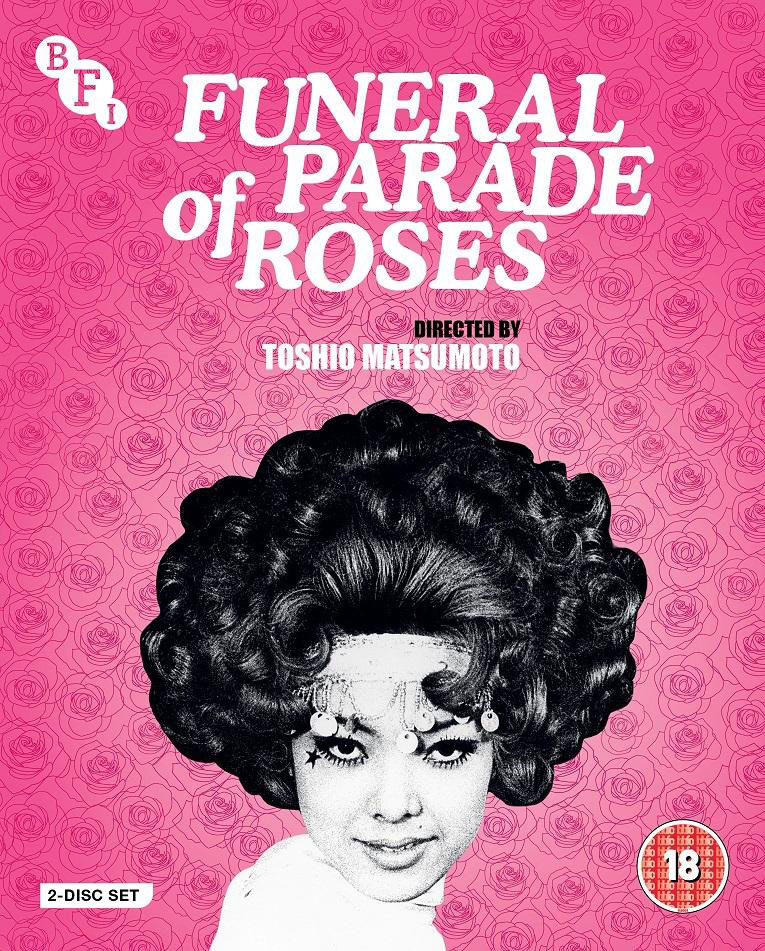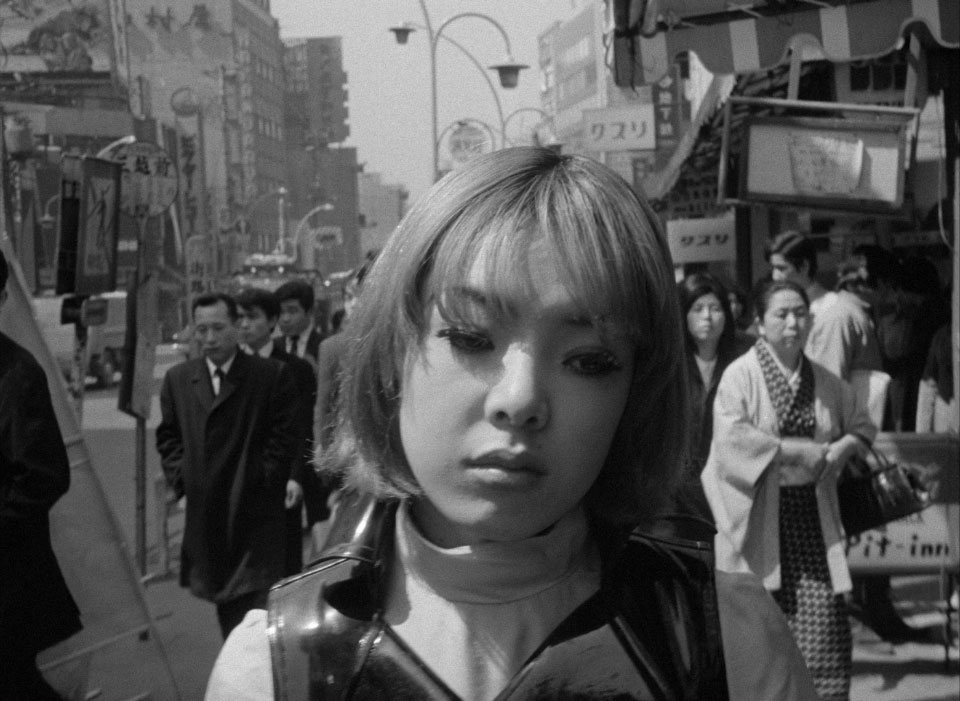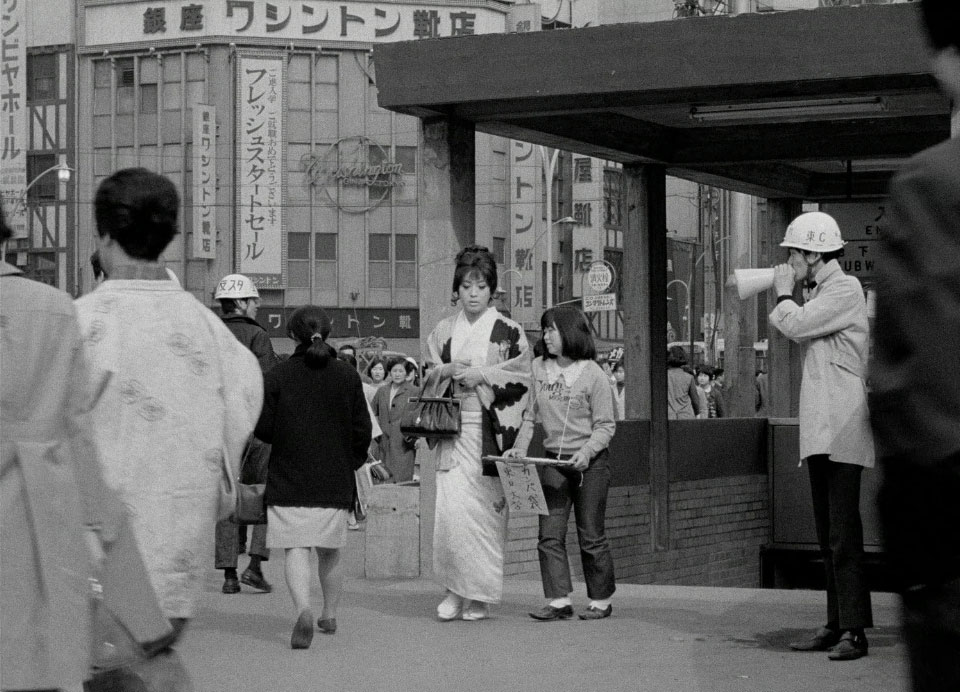
Director: Toshio Matsumoto
Writer: Toshio Matsumoto
Cast: Pîtâ, Osamu Ogasawara, Yoshio Tsuchiya
Producers: Sumiko Fujisawa, Mitsuru Kudo, Keiko Machida
Music: Jôji Yuasa
Cinematography: Tatsuo Suzuki
Editor: Toshie Iwasa
Cert: 18
Running time: 105mins
Year: 1969
FILM: 
EXTRAS: 
Funeral Parade of Roses is released as part of the BFI Japan 2020 season, now on BFI Player
Click here for Japan 2020
What’s the story: In Tokyo, 1969, transsexual Eddie (Pîtâ) attempts to forget the traumatic events of her past.

What’s the verdict: Always referred to as the film Kubrick cited as an influence on A Clockwork Orange, Funeral Parade of Roses dazzles over 50 years since first release.
A stunning tapestry film, it is pitched somewhere amidst the radical formalism and politics of Nagisa Oshima and Jean-Luc Godard, the queer cinema aesthetic of Warhol’s Factory movies and Hollywood melodrama. Not a background watch while flicking through an iPad then…
Director Matsumoto employs the once-radical devices we have come to expect of European and Japanese New Wave filmmaking: jump cuts, on-screen text, fourth wall shattering, frank depictions of transgressive subject matter.
Some of these techniques retain their original impact. Repeated shots of a cigarette burning through a face in a photograph are disquieting. An intimate gay love scene cuts to a shot of the film crew tightly packed into the bedroom before proceedings move to a cast interview.
Still fresh to modern audiences is the film’s depiction of gender fluidity. Matsumoto wryly slips this into the filmmaking and storytelling, with things often not what they seem. Scenes are revealed as reflections in mirrors, flashbacks and flashforwards are difficult to separate, heterosexual sex scenes are revealed as homosexual.
Androgynously beautiful lead Pîtâ (who would later appear in Akira Kurosawa’s Ran) embodies this fluidity. In a face off between Eddie and her friends and a delinquent girl gang, Matsumoto ensures his transsexual actors are more femininely attractive, while the girl gang act defiantly masculine.

Interviews with cast and transsexual non-actors also speak to this; despite blanket reference to them as “gay boys”, interviewees describe a variety of sexual preferences.
Amidst beatnik filmmakers smoking pot and discussing theory, political performance artists, Oedipal allusions and nods to transgressive French writer Jean Genet and filmmaker Pier Paolo Pasolini, Matsumoto proves himself an assured dramatic director across two plot strands.
First, Eddie’s clandestine affair with drug dealer Gonda (Seven Samurai’s Tsuchiya), behind the back of Leda (Ogasawara), club manager and Eddie’s boss. Second, flashbacks to Eddie’s trouble childhood and a formative traumatic event. In traditional storytelling style these dovetail as the film reaches its conclusion.
Although Matsumoto keeps an arch modernist distance throughout; the bloody climax is undercut by a well-groomed film critic popping up to comment on how shocking and moving all this is.
Funeral Parade of Roses’ influence can be felt in Takashi Miike’s 2001 shocker Visitor Q, another transgressive examination of Japanese family strife that riffs on Greek legend and Pasolini. Also, a to-camera interview with Pîtâ in which he reveals the film’s ending is weirdly reminiscent of a massive spoiler Tarantino includes early in Kill Bill Vol.1.
One of the finest films to emerge from Japan’s New Wave cinema of the 1960s.
DISC AND EXTRAS

The Blu-ray transfer of a new 4K scan showcases the monochrome photography to stunning effect. Funeral Parade of Roses is a film of textures, and the close-ups on skin and other details are captured here in astonishing clarity. If you are a fan with a DVD copy on your shelf, it is time to upgrade.
This two-disc edition includes a feature length audio commentary by film historian, poet, actor and all-round polymath Chris D., trailers (featuring footage not included in the film), and eight restored experimental shorts Matsumoto made between 1961 and 1975.
Illuminating throughout, Chris D.’s audio commentary identifies key actors and directors who appear in the film, discusses political and artistic references, and places the movie within the wider context of 1960s Japanese cinema. A cinema that was more experimental following the shift away from traditional studio output.
We could have done with more information on Matsumoto before and after Funeral Parade of Roses, plus information on contemporary reactions to the film. But, the talk track is an engaging examination of a layered movie.
The second disc features the eight experimental films, ranging from a documentary on the rights of kimono weavers in southern Japan to aggressively avant-garde trance shorts. That kimono weaver documentary and another on quarrying precious stone, comprised only of still images, are most accessible. The other films are more suited to gallery installations, but feature imagery and rhythms that become hypnotic and do linger in the mind.
An essential purchase.
Rob Daniel
Twitter: rob_a_Daniel
iTunes Podcast: The Movie Robcast

Pingback: Family Matters: Dr. Alexander Jacoby on Yasujiro Ozu's continued importance